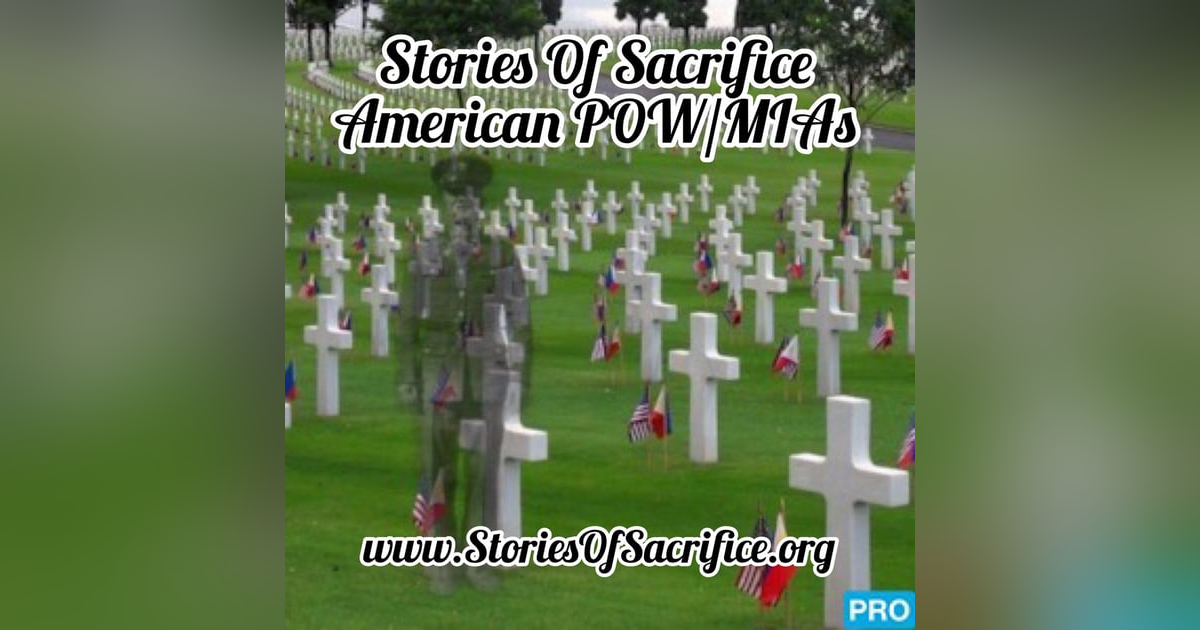Stories of Sacrifice - POW/MIAs - 1LT Alexander R. Nininger (MoH) A Battle That Has Not Ended
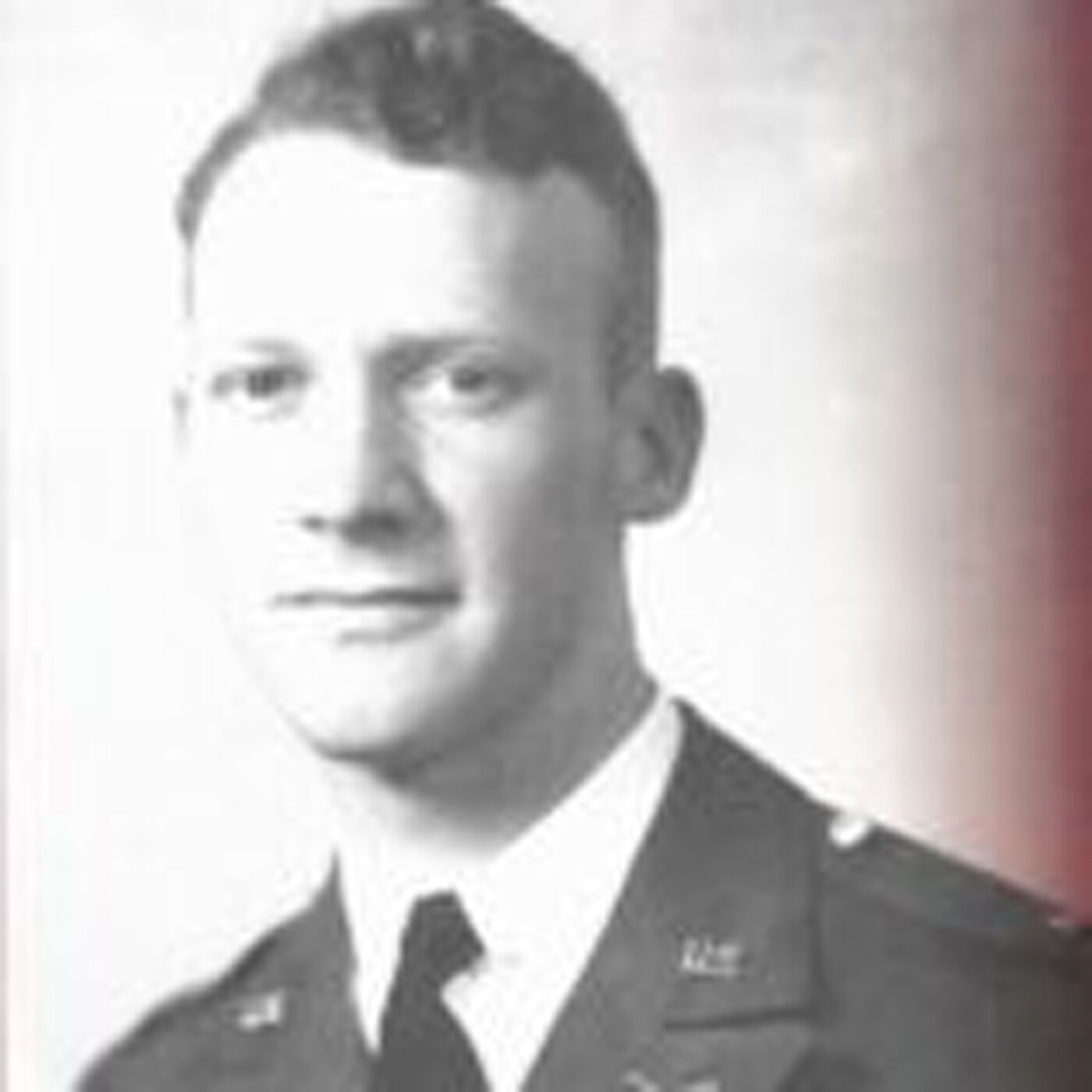
Remains of Medal of Honor Recipient Not Identified Because Army Can’t Unscrew Their Screwup 1LT Alexander “Sandy” Nininger was consigned to the grave of an Unknown Soldier by the celebrity of the Medal of Honor.
Remains of Medal of Honor Recipient Not Identified Because Army Can't Unscrew Their Screwup
1LT Alexander “Sandy” Nininger was consigned to the grave of an Unknown Soldier by the celebrity of the Medal of Honor.
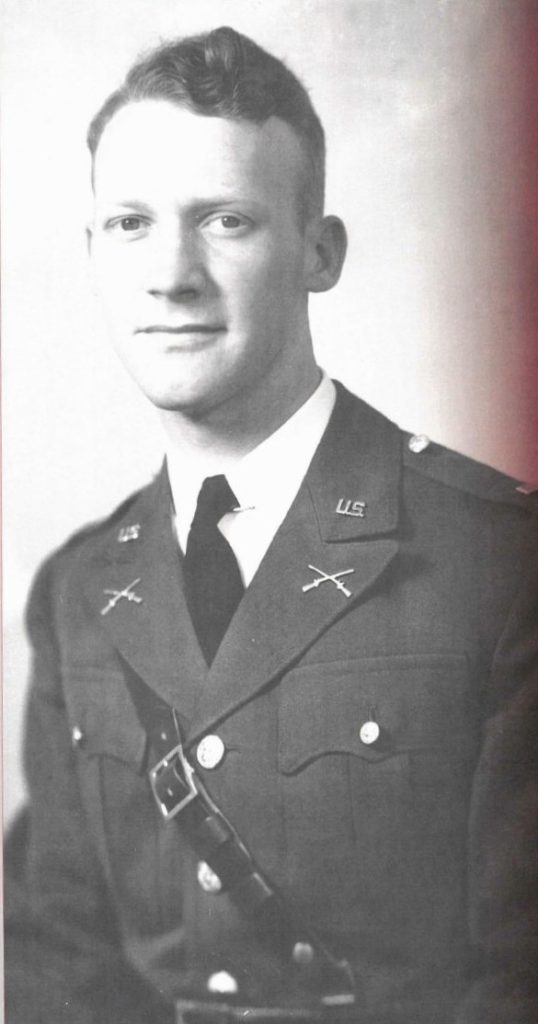
In the early, dark days of World War II, America needed something to feel good about and the courage of 1LT Alexander Nininger was just the thing. Sandy came through for America and American bureaucracy returned the favor by consigning his remains to eternity as an Unknown Soldier.
Ironically, Ira Cheaney and Alexander Nininger, best friends at West Point, died many miles and days apart only to be reunited in death by the deception promoted by their former commanding officer, Colonel George S. Clarke.
Citation: For conspicuous gallantry and intrepidity above and beyond the call of duty in action with the enemy near Abucay, Bataan, Philippine Islands, on 12 January 1942. This officer, though assigned to another company not then engaged in combat, voluntarily attached himself to Company K, same regiment, while that unit was being attacked by enemy force superior in firepower. Enemy snipers in trees and foxholes had stopped a counterattack to regain part of position. In hand-to-hand fighting which followed, 2d Lt. Nininger repeatedly forced his way to and into the hostile position. Though exposed to heavy enemy fire, he continued to attack with rifle and hand grenades and succeeded in destroying several enemy groups in foxholes and enemy snipers. Although wounded 3 times, he continued his attacks until he was killed after pushing alone far within the enemy position. When his body was found after recapture of the position, 1 enemy officer and 2 enemy soldiers lay dead around him.
Just as COL Clarke's self-serving deception prevented the identification and burial of 1LT Ira Cheaney, it also insured that five of 1LT Cheaney's comrades – Lt's Nininger, Maynard, Green, Compton and Wilson – would also become Unknowns. With the complication of the award to 1LT Nininger of the Medal of Honor, their cases became hot potatoes that no one wanted to touch even with overwhelming evidence of the identity of their remains.
Sandy Nininger and several of his comrades were recovered just as were most of the Bataan casualties, by Master Sergeant Abie Abraham. Sergeant Abraham was quite a colorful character in his own right. He had fought on the left flank of Cheaney and Nininger’s 57th Infantry at Abucay. He knew many of the officers and men of the Philippine Scout units. After more than three years in a POW camp, he was personally selected by General MacArthur to head up recovery of remains on Bataan. Married to a Filipina, he spoke the language and understood the local population.
After his return to the States several years later, MSG Abraham wrote two books about his experiences in the Philippines. Nininger was prominently mentioned with no indication that there was anything unusual about the recovery of his remains. This was a routine recovery until Washington insisted that they knew more than the people on the ground in the Philippines.
The first page of the X-1130 file shows that Abie interviewed the local gravedigger who stated that he had buried five Americans in the Abucay Cemetery in January 1942.
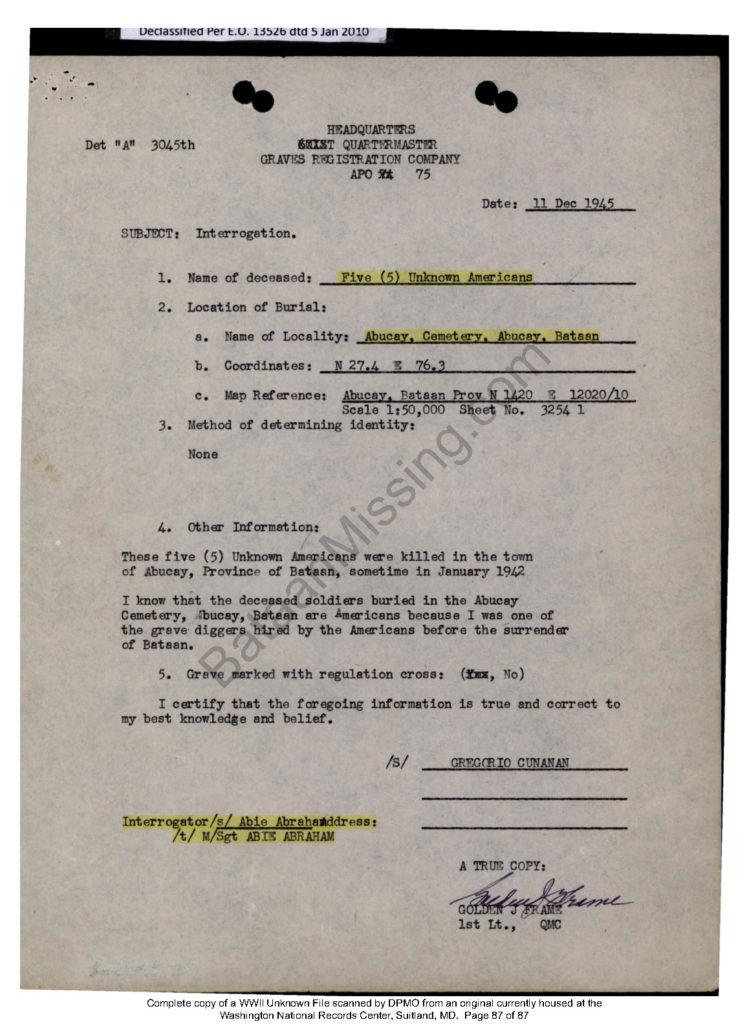
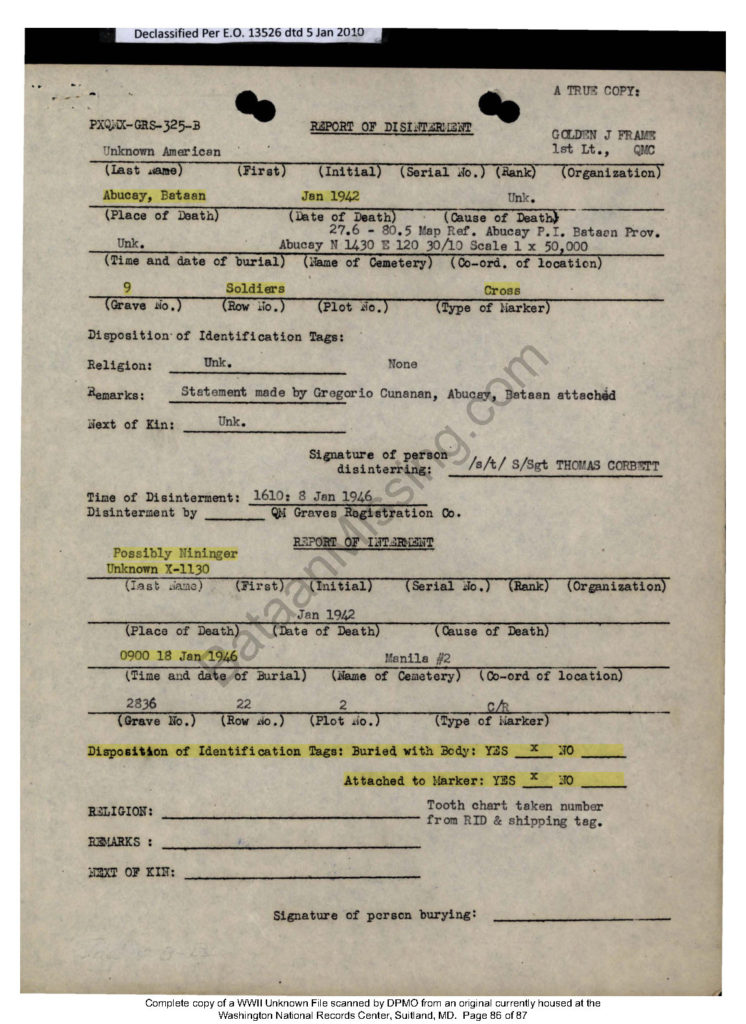
Based on this information, on 8 January, 1946, the remains were disinterred and transferred to the Manila #2 cemetery where they were assigned the number X-1130 with the notation that they were “Possibly Nininger.”
There is no existing record that tells us what information MSG Abraham relied upon in determining that grave #9 was Nininger’s, but nearby graves in the same row were identified either by the name on the grave or by reference to records.
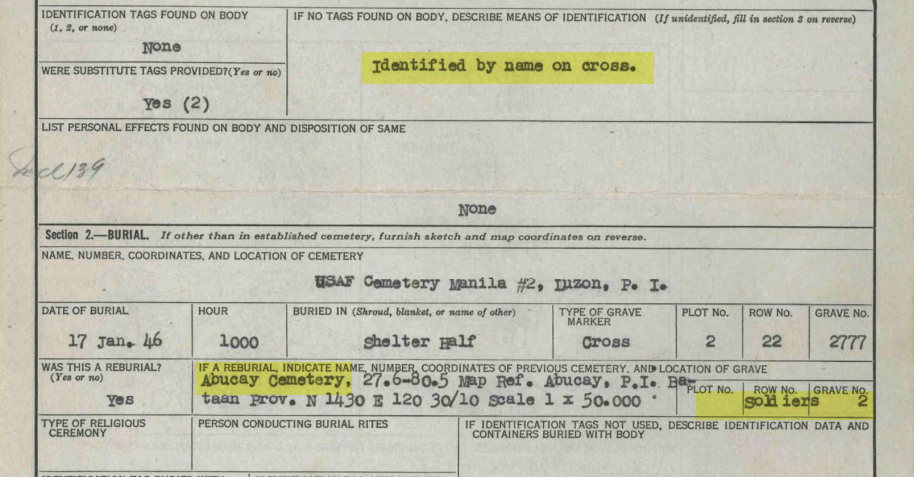

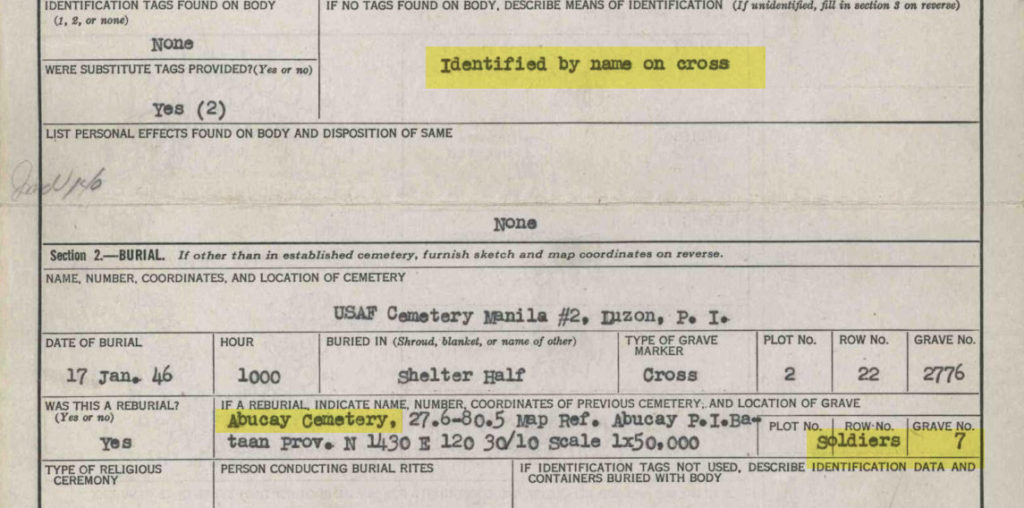
As the investigation progressed and additional information was obtained, a report of interment was prepared and updated with different typewriters and pens as information became available.
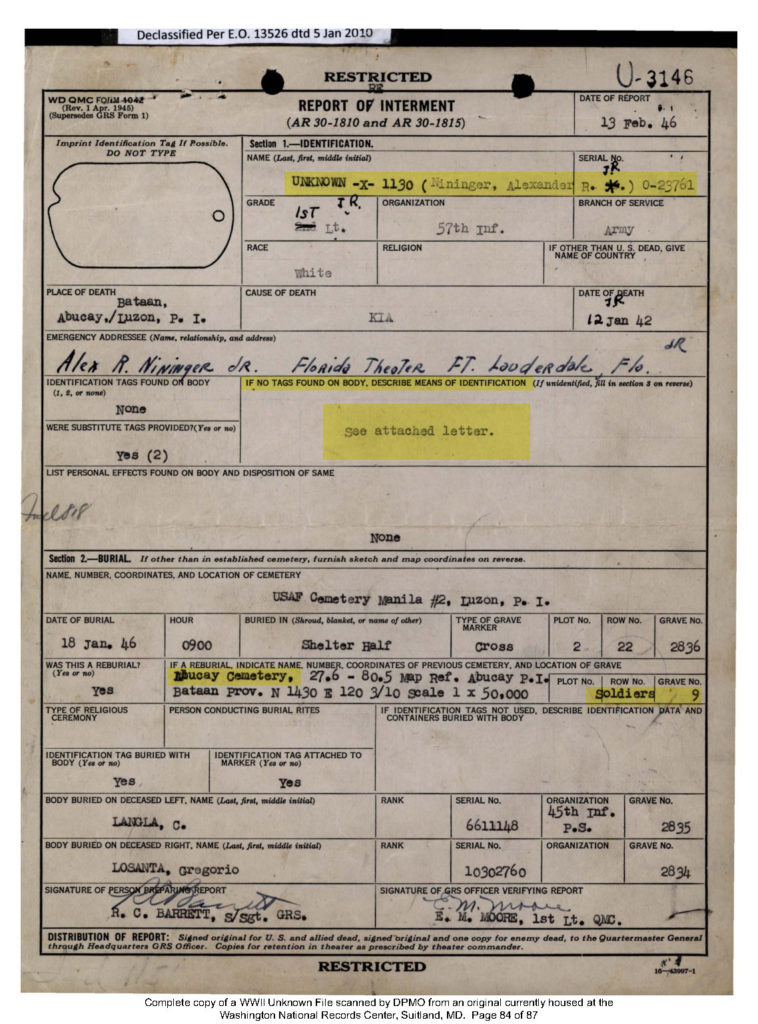
According to the Report of Interment, the means of identification was described in an attached letter that the Army somehow lost and is no longer with the Report of Interment.
By 13 February, 1946, the investigation was complete and X-1130 had been preliminarily identified as the remains of 1LT Alexander Nininger. The identification was then presented to a board of officers in a quasi-judicial proceeding convened by the local command where all the evidence described in the “attached letter” and and all the witnesses pertaining to the identification were available.
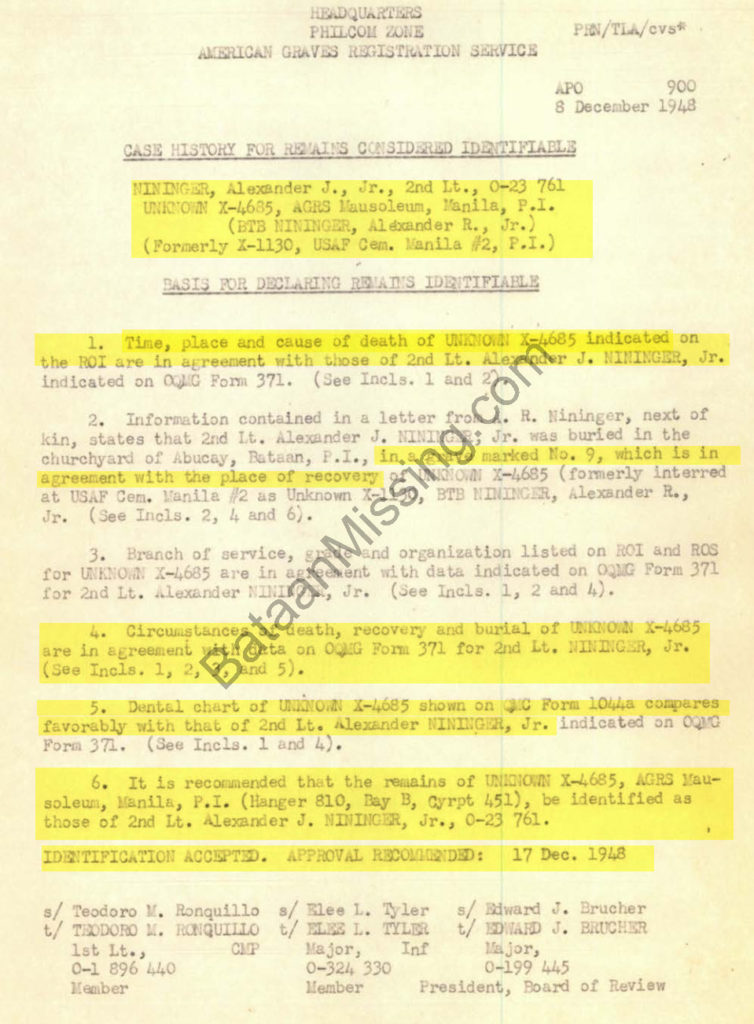
The board unanimously recommended that remains X-1130 be identified as 1LT Alexander Nininger. On 27 December, 1948, the local commander transmitted to the Memorial Division in Washington, DC the findings of the board of officers with his recommendation that X-1130 be identified as the remains of 1LT Nininger.
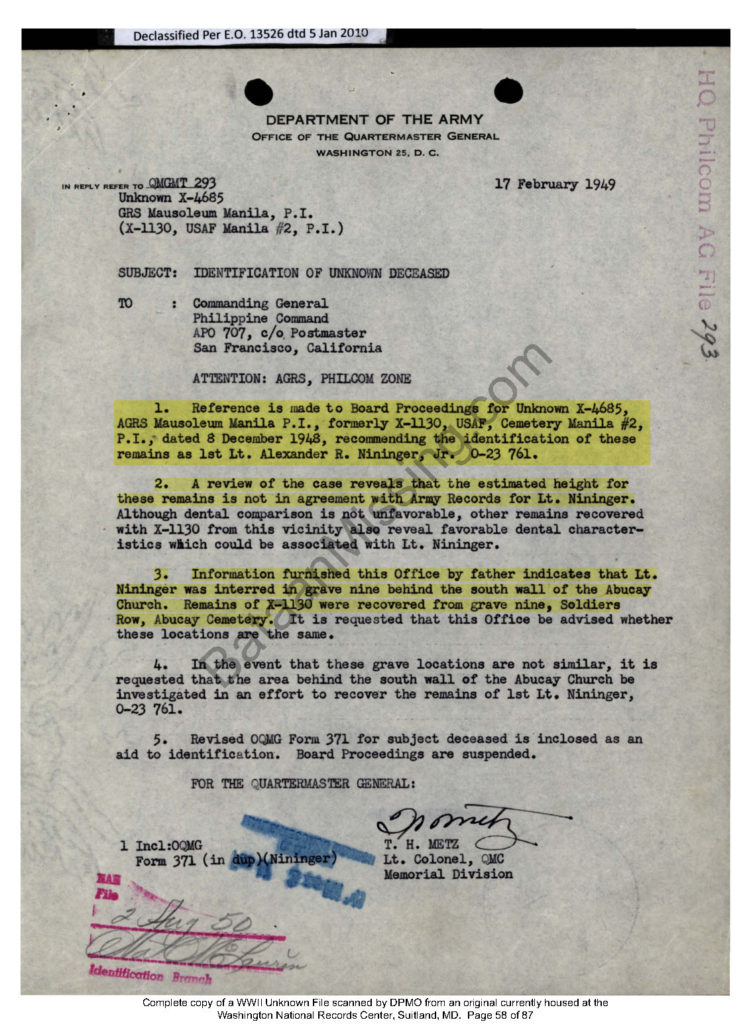
The Memorial Division rejected the board’s recommendation for two reasons:
1. The estimated height for these remains did not agree with Lt Nininger’s known height.
2. Information received, through the family, from Colonel Clarke, that indicated that 1LT Nininger had been buried in Grave #9 of the Abucay Churchyard and the X-1130 remains had been recovered from Grave #9 of the nearby Abucay town cemetery.
The first reason given for disapproval of the recommendation to identify X-1130 as Nininger was that while the dental comparison was not unfavorable, the estimated height of the remains didn’t match his known height. However, these estimates were later proven to be badly in error of the actual height.
In the early 1950’s, Professor Mildred Trotter, an anthropologist at the Department of Anatomy, Washington University, published a series of academic papers based on her work at the Schofield Barracks Mortuary identifying the remains of World War II American casualties.
Professor Trotter found that the formulas and tables previously used in the identification of American servicemen had been based on observations of a 19th Century French population and they substantially understated the actual, ante mortem, height of the modern American servicemen.
COL Clarke had specified that Nininger was buried in “Soldiers Row Grave 9” of the Abucay Church and X-1130 was found in “Soldiers Row Grave 9” of the Abucay (town) cemetery. Perhaps that was just a coincidence or perhaps someone confused the locations which were only a few hundred yards apart – both were cemeteries and both were in the town of Abucay.
The Memorial Division noted the similarity of the grave locations and asked if the Abucay Churchyard and Abucay Cemetery were one and the same location and directed further investigation.
Colonel Clarke had struck again. First the remains of Cheaney, now Nininger was missing because Clarke had provided incorrect information on the burial that occurred when he wasn’t even present on Bataan when they died.
Note that the X-1130 remains had been re-designated as X-4685 when they were removed from Manila Cemetery #2 to the Manila Mausoleum.
The local Graves Registration command, in an unprecedented move, re-investigated the case as directed by Washington; convened a new board of officers; and, again presented to Washington the recommendation that the X-1130 remains be identified as those of 1LT Nininger.
This time they added an explanation of why they didn’t believe that 1LT Nininger had been buried in the Abucay Churchyard. They first noted that the churchyard location was provided by the father of one of the other officers who stated that Lt’s Nininger, Maynard, Wilson, Compton, Green and Captain Meyer had all been buried in the churchyard. They then noted that the records for 1LT Nininger had been compared with all remains recovered from the churchyard with negative results. Further, the remains of Lt Maynard, Lt Wilson and Capt Meyer had all been recovered from other locations and positively identified. The obvious conclusion was that the churchyard burial location was clearly erroneous.
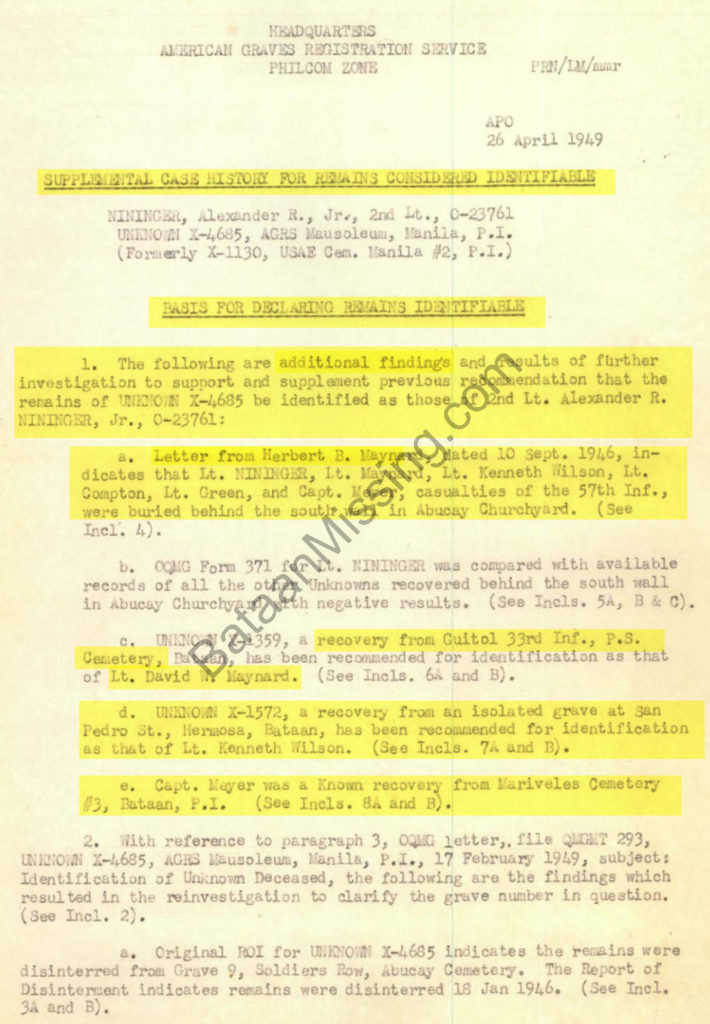
The board’s report then explained that the remains recovered from Grave #9 at the Churchyard had been identified as those of a Philippine Scout, PFC Tranquilino Bales, 6738585, by means of an identification tag. Further, 1LT Nininger’s dental records didn’t compare favorably with these remains.
The report stated that the X-4685 (previously X-1130) remains [recovered from Grave #9 at the Abucay Cemetery] were those of Lt Nininger and unequivocally recommended their formal identification as such.
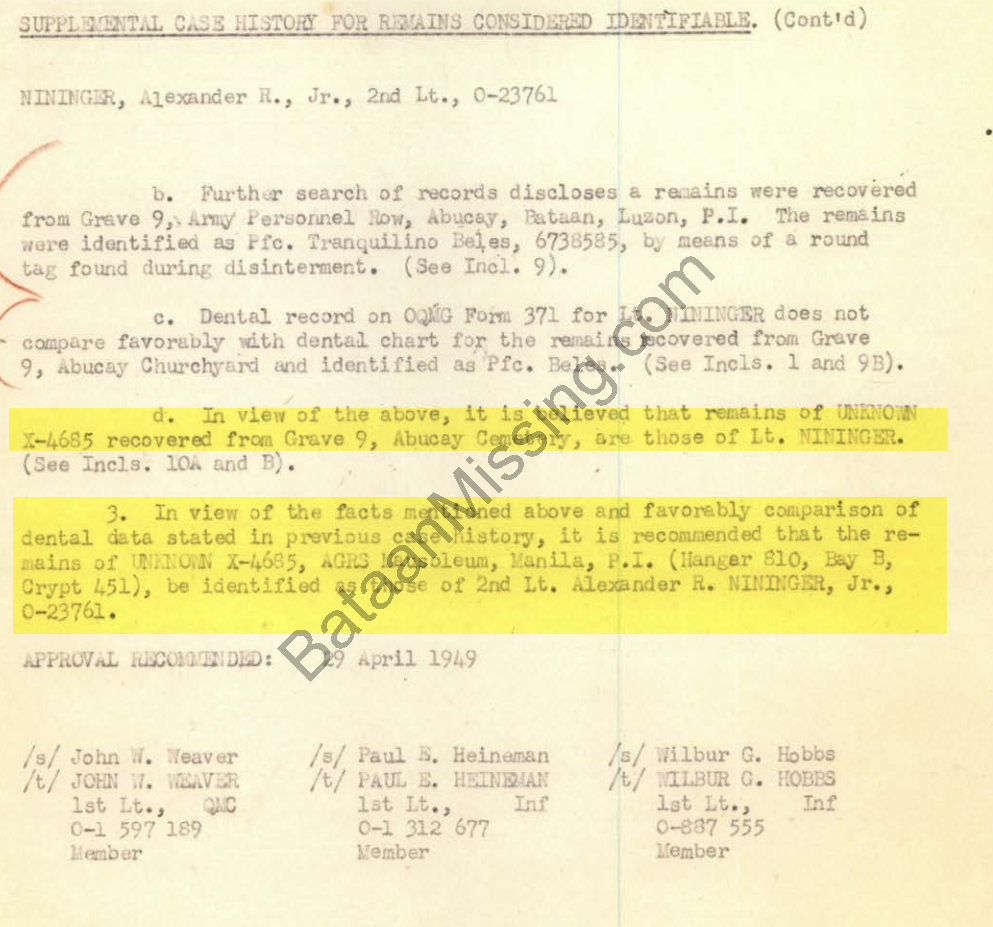
Undeterred by the recommendation of the second board to consider the case, the Memorial Division again disapproved their recommendation based on additional information they had received from LTC Raulston indicating that Nininger had been buried in the Abucay Churchyard and the X-1130 remains were recovered from the Abucay Cemetery. The local command was instructed to re-investigate the facts of the investigation for the third time – and submit a report.
It was later found that LTC Raulston never claimed to have been present at the burial of Nininger or others, but simply stated that burials had been made in the churchyard.

After the third investigation, on 7 March, 1950, the local Graves Registration command in the Philippines submitted a point by point discussion of the issues raised by the Memorial Division with regards to Lt Nininger.
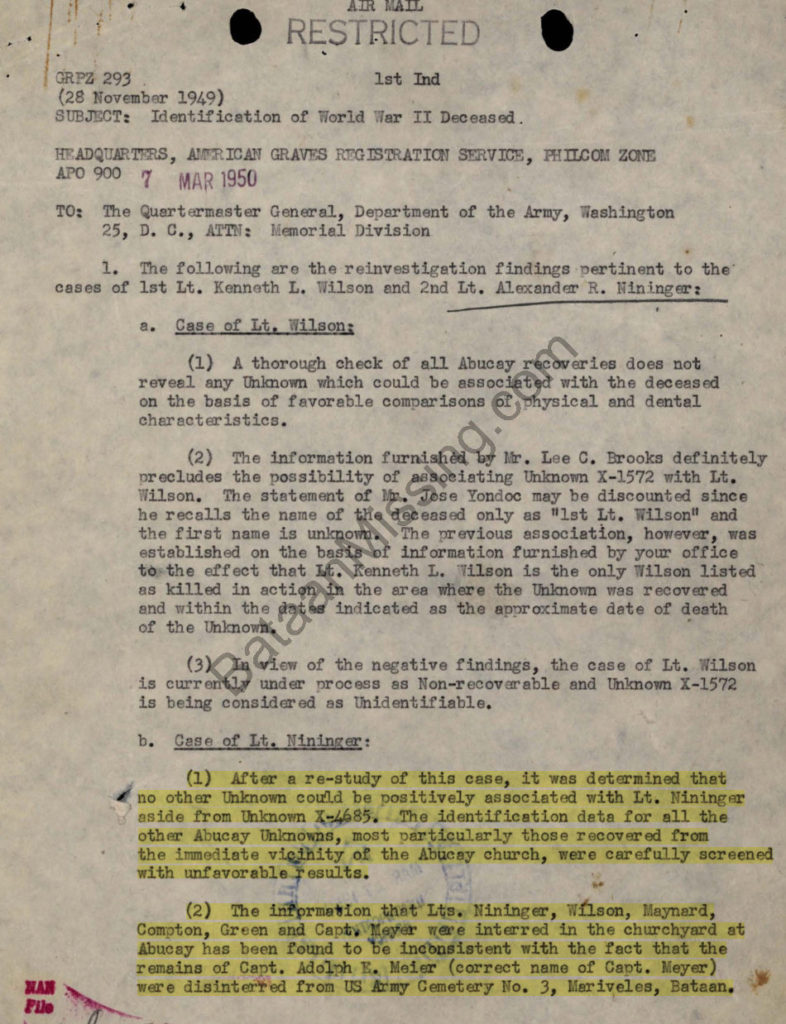
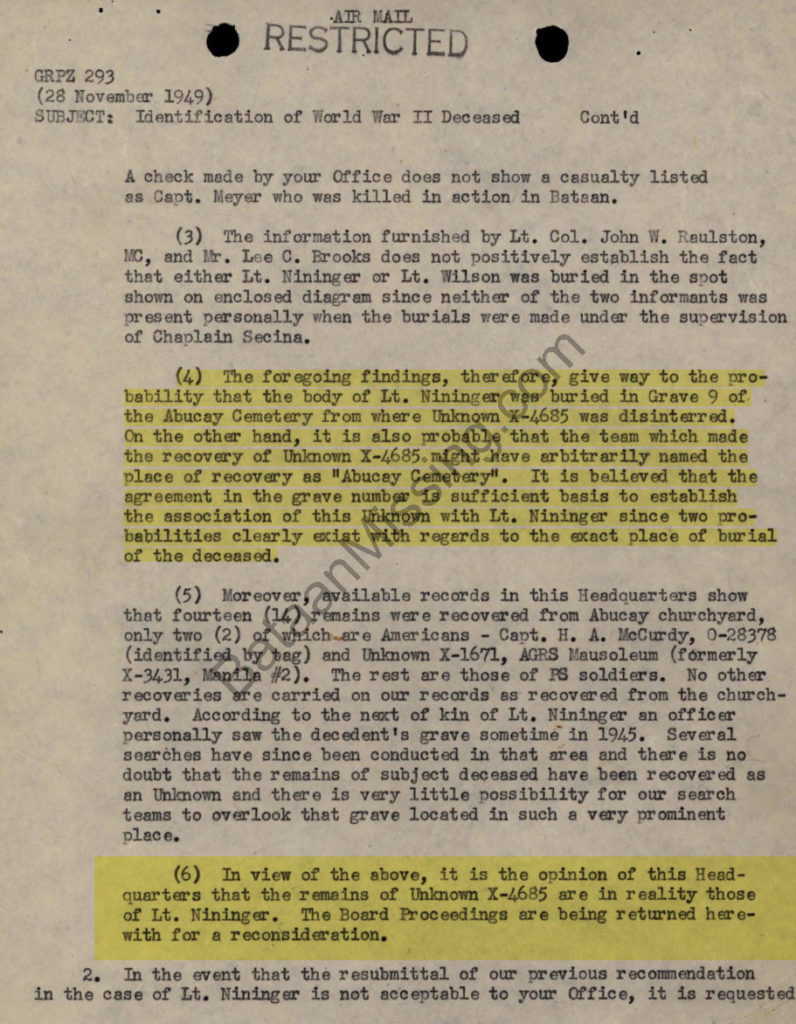
Note the unconditional statement that X-4685 (previously X-1130) is actually 1
LT Alexander Nininger.
The resubmitted recommendation noted the probability that the body of Lt. Nininger was buried in Grave 9 of the Abucay Cemetery from where Unknown X-4685 (previously designated as X-1130) was disinterred. On the other hand, it is also probable that the team which made the recovery of Unknown X-4685 might have arbitrarily named the place of recovery as “Abucay Cemetery” since it was a cemetery and it was in the town of Abucay. It is believed that the agreement in the grave number is sufficient basis to establish the association of this Unknown with Lt. Nininger since two probabilities clearly exist with regards to the exact place of burial of the deceased.
The Philippine command didn’t equivocate when they stated, “In view of the above, it is the opinion of this Headquarters that the remains of Unknown X-4685 are in reality those of Lt. Nininger. The Board Proceedings are being returned herewith for a reconsideration [by the Memorial Division].”
Washington was not to be deterred until they got what they wanted. They wanted off the hook for botching the identifications of these five fine young officers. They knew that Niningers’ Medal of Honor would draw intense scrutiny of everything they had done and that kind of attention is never good in the Army.
The Memorial Division quickly directed the Graves Registration command to conduct another re-investigation and reconsider what was their third recommendation to identify X-1130/X-4685 as Nininger.

The Graves Registration command in the Philippines was determined to put this case to rest and they pulled out all the stops to thoroughly excavate the Abucay Churchyard. They sent a detail of twenty-five laborers, one embalmer and their supervisor to Abucay.
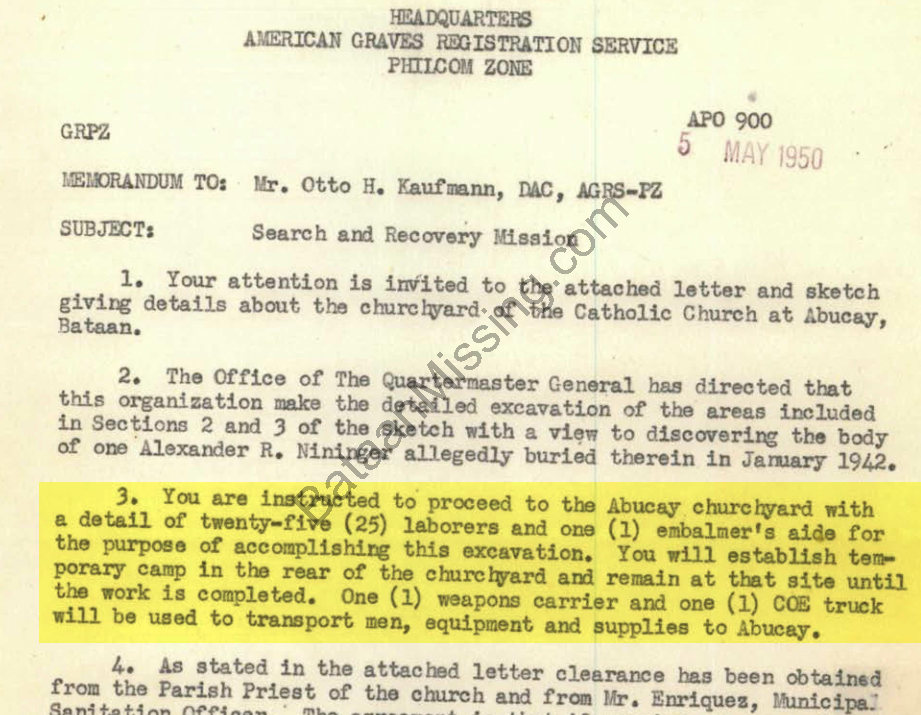
The search detail dug trenches two feet wide and four feet deep every three and one-half feet in the churchyard. They recovered the partial remains of eighteen persons and returned them to the Central Identification Laboratory for processing.
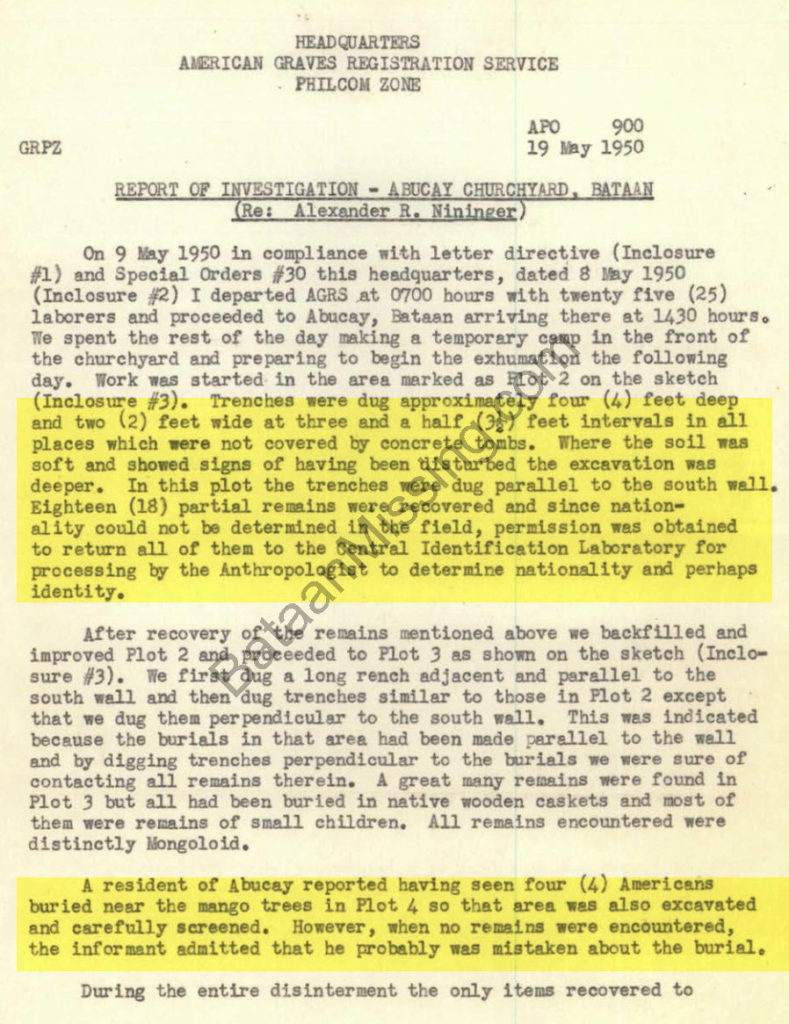
The eighteen remains were examined by an anthropologist and all were determined to be of Philippine ancestry.
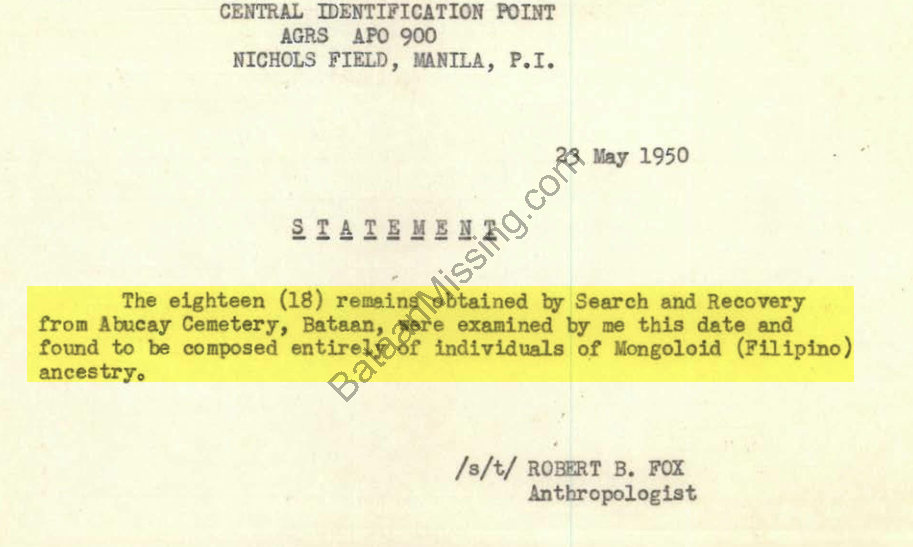
Despite the recommendations of two boards of officers and an extensive excavation of the churchyard, on 12 September 1950, the Memorial Division got what they had demanded, the remains of 1LT Alexander Nininger were officially declared non-recoverable. The Graves Registration command had the last word, though, insisting that the X-1130/X-4685 remains were those of Nininger, but their recommendation had been rejected and they reiterated that LTC Raulson had not been present at the burials.
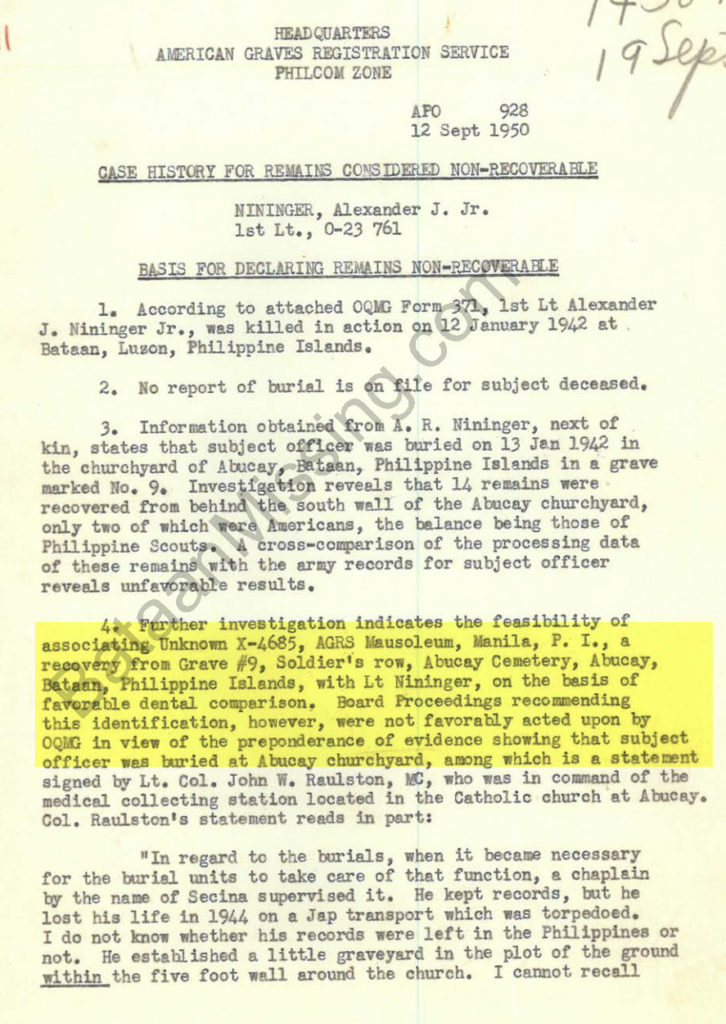
Just seventeen days later, the remains were quickly laid to rest in grave J-7-20 of the Manila American Cemetery. Under means of identification, they added “Nininger, A.R. Jr. O-23761.”
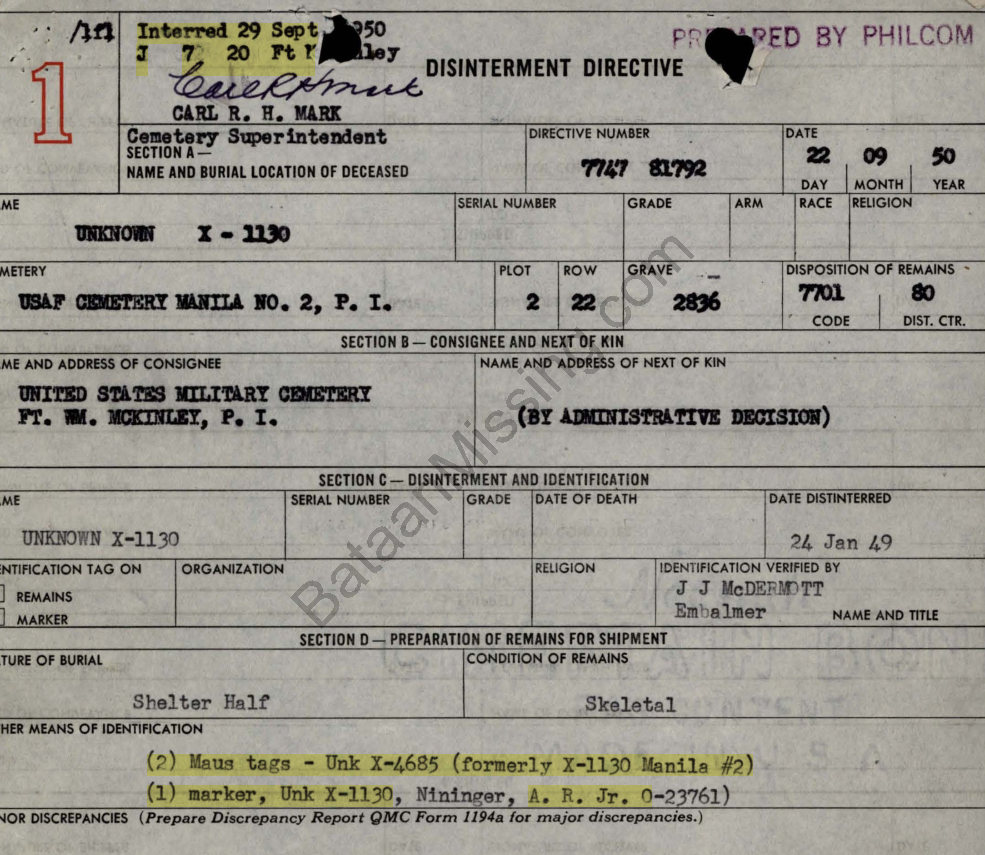

Headstone on Grave J-7-20 of the Manila American Cemetery.
A few weeks after Sandy’s burial, in October 1950, Captain Vogl of the Memorial Division began his investigation that revealed that Colonel Clarke had provided incorrect information on the burials of Ira Cheaney, Alexander Nininger and several others. Without Colonel Clarke’s erroneous information, the X-1130/X-4685 remains likely would have been quickly identified as those of 1LT Alexander R. Nininger as recommended by the review board.
Was Clarke trying to comfort the families? Was he trying to rehabilitate his reputation by implying that he was present when he wasn’t? Or, did he simply make a few honest mistakes, perhaps confusing Cheaney and Nininger and saying Cheaney was buried in Abucay and Nininger was buried in grave 9 of the churchyard when he was actually buried in grave 9 of the nearby cemetery?
For whatever reason Clarke had provided incorrect burial information, the Army had an even bigger problem. At this point, the Army knew they had made mistakes – BIG mistakes. Even in the face of overwhelming evidence that it was incorrect, Washington had chosen to cling to information provided by a disgraced colonel.
Clarke’s incorrect burial information had caused someone to wrongly be buried as 1LT Cheaney at West Point and Lt’s Compton, Green, Maynard, Wilson and 1LT Nininger, a national hero awarded the first Medal of Honor of World War II, to all be buried as Unknowns.
The Classified Coverup
If the facts don’t fit the theory, change the facts. If you still don’t like the facts, just hide the evidence.
That’s exactly what the Army’s Memorial Command in Washington did. They had received conflicting information as to the burial location of a hero who had received the Medal of Honor. They dared not be wrong so they ignored all the facts and did nothing – just covered their tracks.
In spite of repeated investigations conducted by the Graves Registration command in the Philippines, Washington chose to overrule their recommendations and rely on the testimony of a discredited officer who wasn’t present and whose testimony had repeatedly been found to be incorrect. When it was learned that they had picked the wrong horse, Washington declared the remains to be non-recoverable, told all the witnesses to toe the official line, and classified the records as defense secrets.
Within days after X-1130 was laid to rest as an Unknown in the Manila American Cemetery, the Memorial Division in Washington began an investigation in to the facts. They interviewed all the presumed witnesses to the burial of 1LT Alexander Nininger. They found that none of them had actually been present, and, quite tellingly, carefully avoided talking to those who actually were present.
The first person interviewed was Colonel George S. Clarke who had commanded the 57th Infantry Regiment (PS) at the time of Nininger’s death. Clarke had been relieved of his command – the ultimate disgrace for a career officer – and ordered to the island fortress of Corregidor before Nininger, Wilson, Compton or Green were buried. If he had information on the burial locations, it was second hand because he wasn’t present.
Clarke left the Philippines on the last submarine out and made his way back to the States. While the war raged in the Pacific theater, Clarke was in touch with the families of some of the men he had lost. We’ll never know if Clarke was trying to redeem his tarnished image or somehow comfort the families, but he told them in flowery language that their sons had been buried in the Abucay churchyard rather than their actual burial sites.
The families accepted Clarke’s incorrect information as gospel and shared it with the Army and their congressional representatives. The Army’s Memorial Division not only believed Clarke’s information as it was coming from the families and members of congress, they continue to stand on it to this day even though it has been repeatedly shown to be false.

The next to be interviewed was Lieutenant Colonel Anders. He explained that Clarke had been relieved and had left Bataan. He unequivocally stated that Clarke had not attended the burials. In later interviews, Anders stated that he and Major Francis were the only ones present for the burials. And while Anders first placed the burials in the Abucay churchyard, he later confessed to some confusion about the burial locations.

Major Sanders, another officer of the 57th Infantry, informed the investigators that Major Francis had assisted Chaplin Scecina with the burials and would have been present for them.
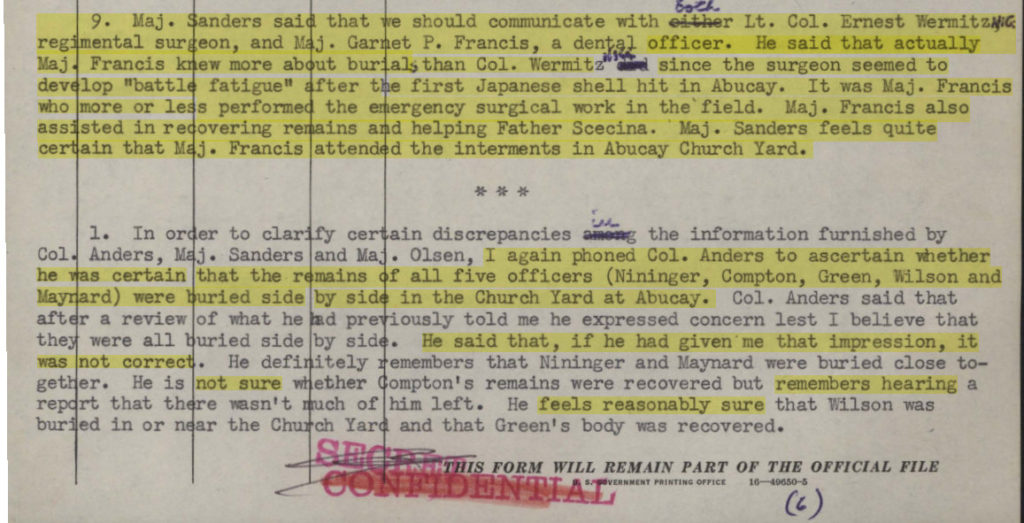
In a second telephone interview, Anders again demonstrated some confusion about the burial locations.
Next to be interviewed was Major John Olson who said that LTC Anders and Major Francis attended the burial services.
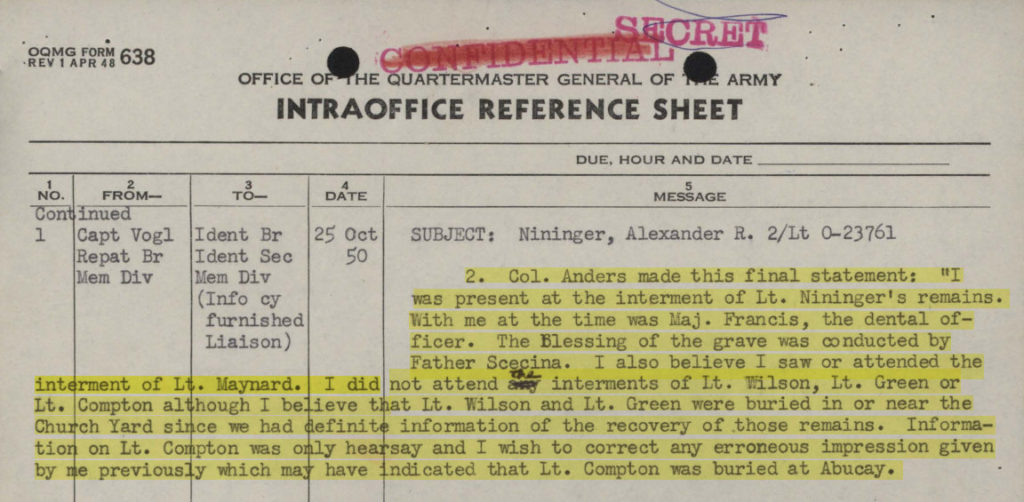
When interviewed a second time, LTC Anders confirmed that he and Major Francis were present at Nininger’s burial, but he again demonstrated some confusion about the burial locations.
In light of the fact that the Abucay Churchyard had been repeatedly excavated and the remains were not found, it is pretty obvious that they were not buried there.
The bottom line at this point was that:
1. The burial locations given by Clarke were incorrect.
2. Only Major Anders and Major Francis were present for Nininger’s burial.
3. Major Anders stated that Nininger had been buried in the Abucay Churchyard, but showed some confusion about the locations.
4. The churchyard had been excavated at least three times.
5. Major Francis was not interviewed by the Memorial Division investigator, but later placed the burials in the Abucay Cemetery – NOT the Abucay Churchyard.
If they hadn’t yet been convinced that Nininger, Wilson, Compton, Green and Maynard had not been buried in the Abucay churchyard, the investigation conducted by the Memorial Division should have removed all doubt. However, rather than admit their error and accept the identification of X-1130/X-4685 as Nininger’s remains they chose the cowards’ choice and did nothing – except conceal the records.
Still to come – the family’s fifty year quest to find the remains of 1LT Alexander Nininger despite the Army’s continued efforts to conceal their duplicity.
What Classified Files? We Don’t Have Any Classified Files
Not deterred by inconvenient facts, Washington was sticking with Clarke’s bogus story about burials in the Abucay Churchyard even though it had been thoroughly excavated without finding additional Americans.
The Nininger family was equally determined to recover the remains of their son and bury him at home.
The investigation conducted by the Memorial Division had recommended that each of the families be personally visited and briefed on the facts of the case. Since both the families and the Army believed Colonel Clarke’s story about the burials in the churchyard it wasn’t a difficult sell. Perhaps if the families had been shown the documents identifying the X-1130/X-4685 remains or the classified investigation report they wouldn’t have been so quick to agree.
The Nininger family was most concerned that nothing further would be done if the case was closed, but were assured that they would be notified if any remains were positively identified as their son. Of course, the Army didn’t intend to look very hard.

While the Army may have considered the case closed, the Nininger family certainly didn’t. They continued to collect information and interview members of the 57th Infantry.
By 1966, Sandy Nininger’s Nephew, John Patterson, joined the fight. A career foreign service officer, John was organized and able to effectively organize the information he collected.
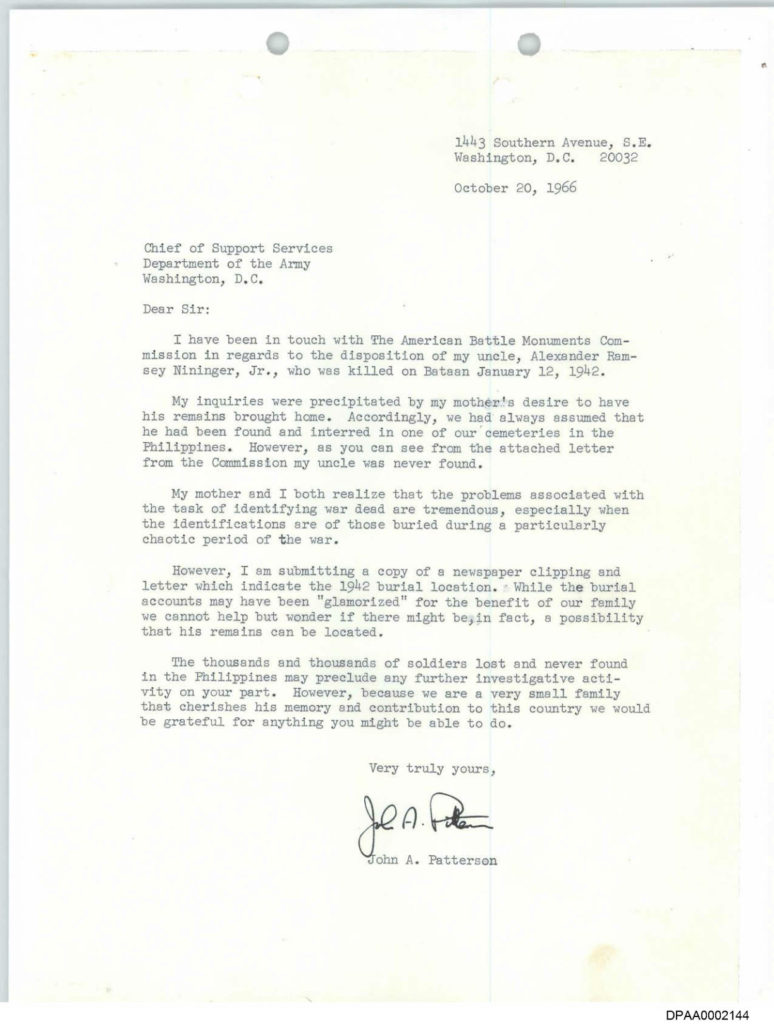
There’s no record that the Army even responded, but by 1986 John Patterson had gathered a huge volume of documents and spoken with those who were present at Nininger’s death. He wasn’t relying on Clarke’s bogus informationand he had found someone who actually attended the burial. He requested that the army reopen the case and, in support of his case, provided a summary of the case and information from the witness the Army knew about, but never interviewed.
Patterson had obtained a copy of Nininger’s Individual Deceased Personnel File and found two references to a classified file filed under the name of 1LT Ira B. Cheaney.

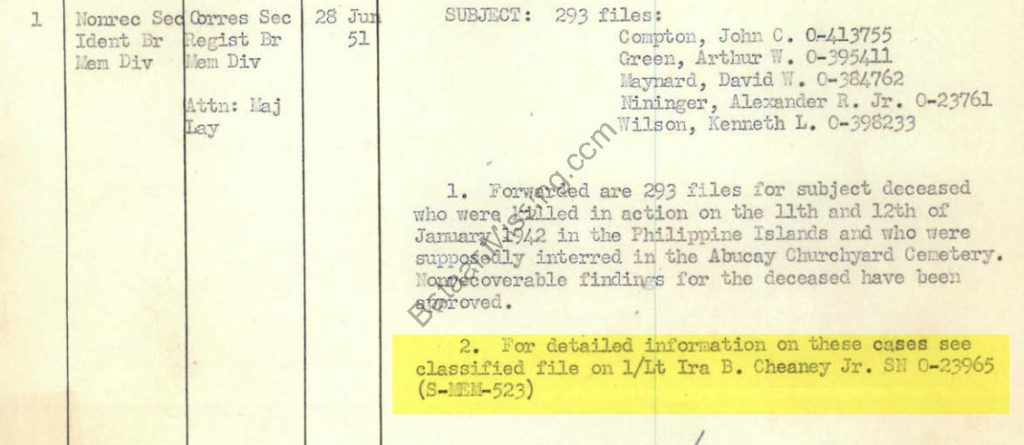
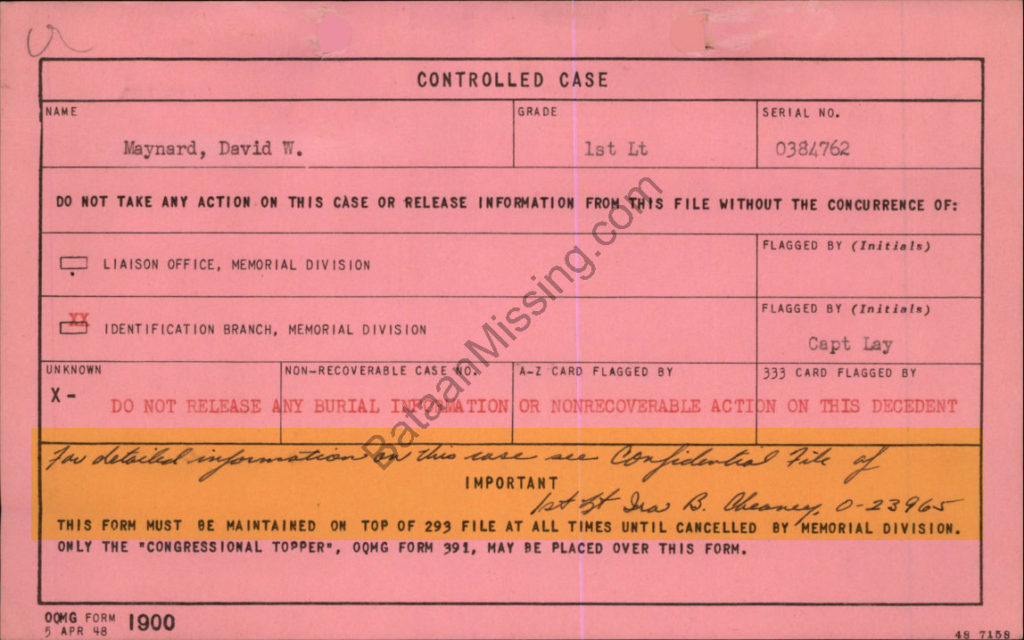
In 1985, Patterson requested a copy of the classified file referenced in his Uncle’s IDPF.
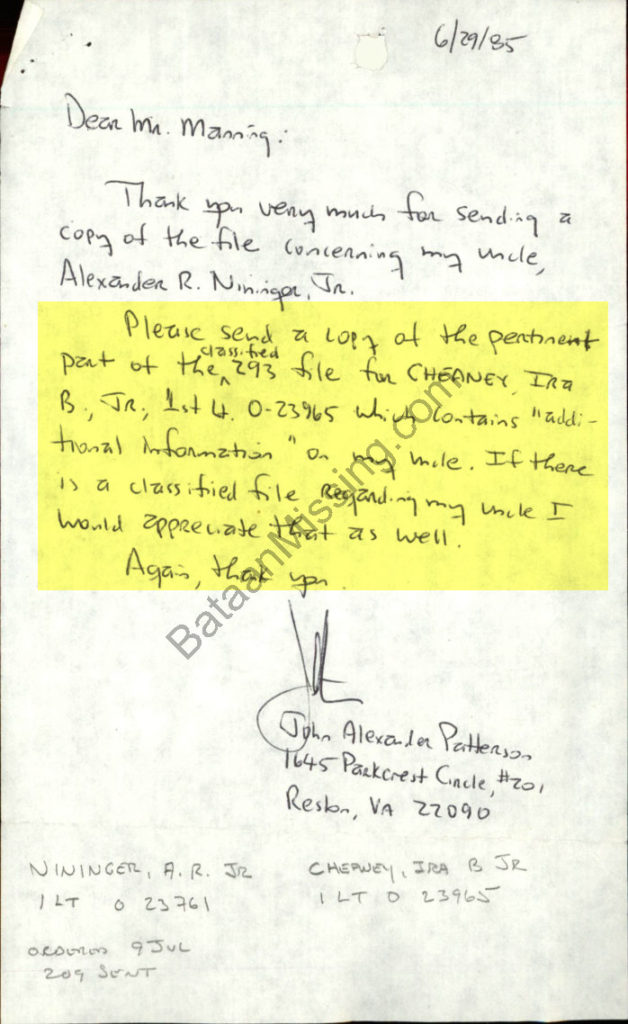
The Army responded and flat out denied the existence of a classified file pertaining to either Cheaney or Nininger.

This classified file was the key to proving that Clarke’s information was incorrect and understanding the actual burial process. What’s more, the file showed that Washington was aware of the facts, but classified them as SECRET to conceal them. No wonder the Army wanted to keep that file hidden.
In 1986, Mr. Patterson requested that the Army reopen his Uncle’s case and provided information on a witness the Army had previously avoided interviewing. However, the Army had known since at least 1951 that Major Garnet Francis had attended the burial and pointedly avoided interviewing him.


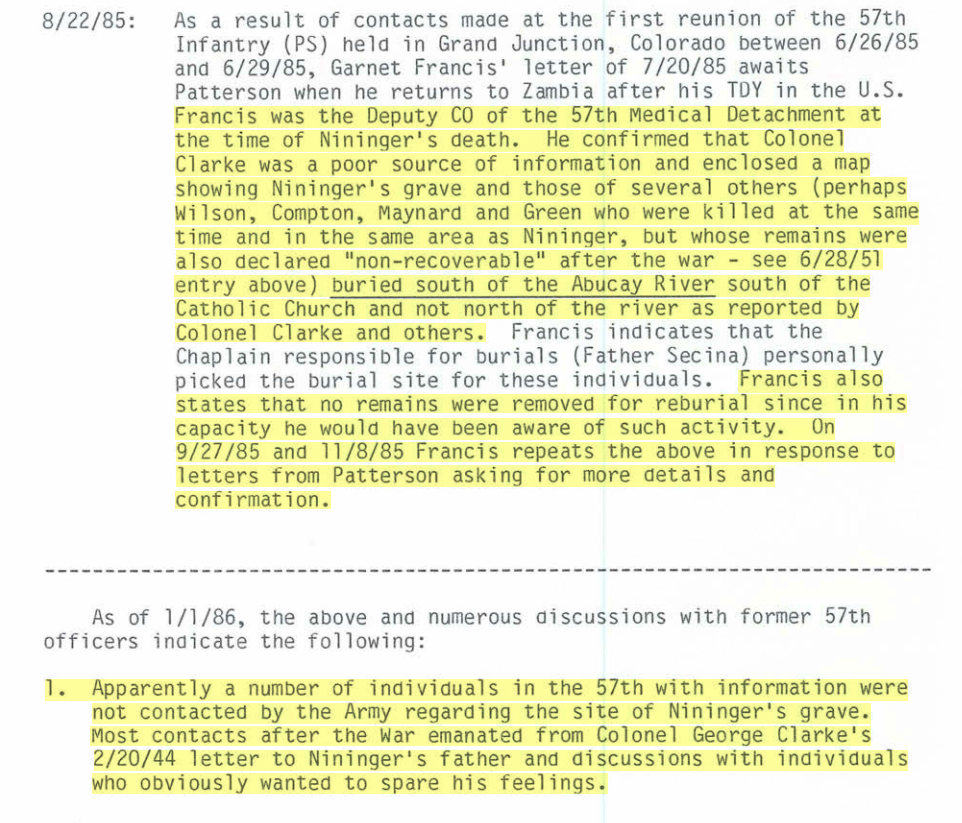
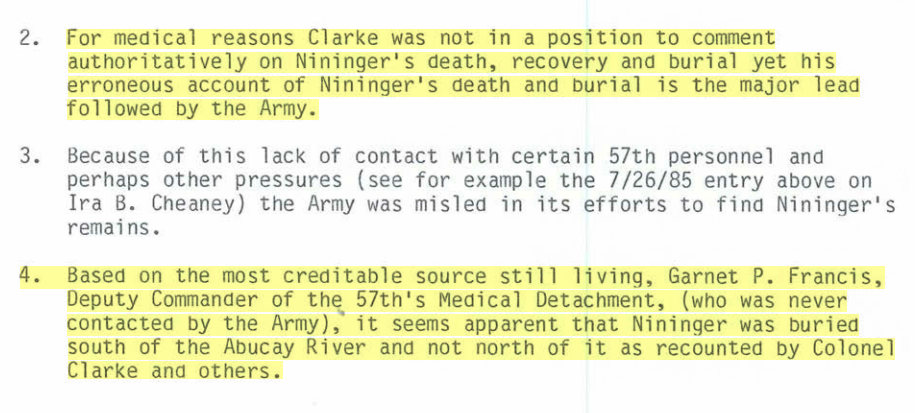
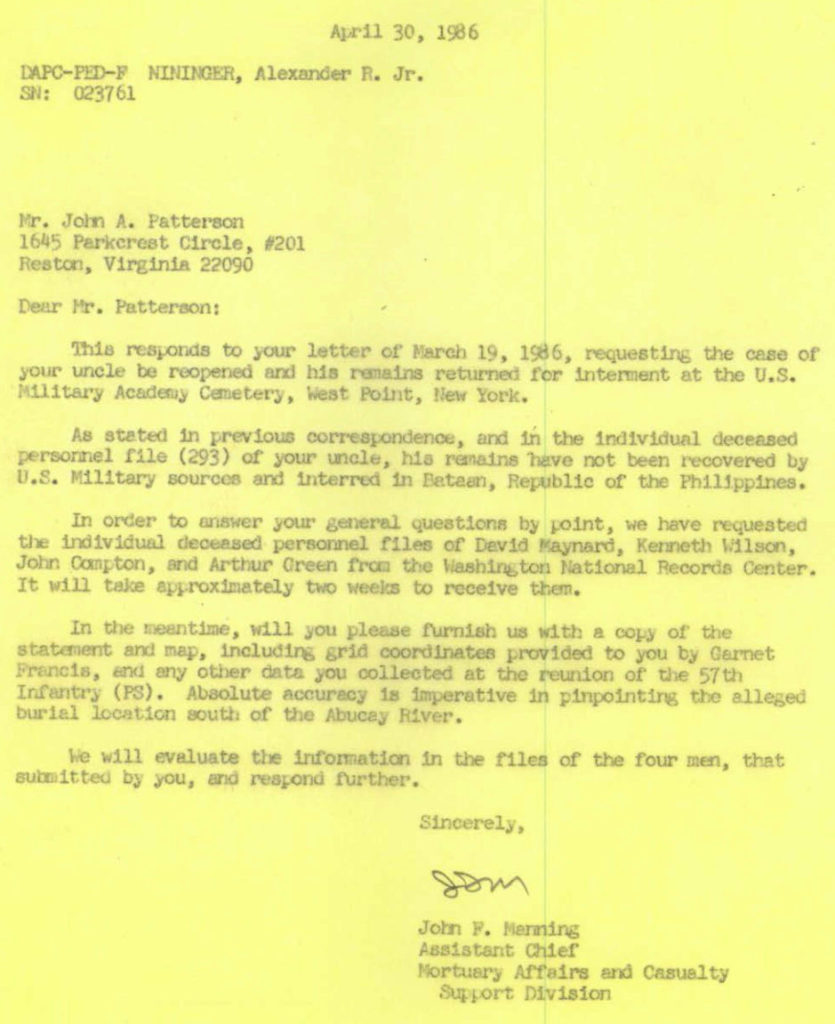
The Army refused or neglected to followup with Major Francis and he passed away a few years later. However, they had the map created by Major Francis that John Patterson had sent them.
In 2012, the Nininger case came to the fore, again, and a young historian, Gregory Kupsky, was assigned to summarize the progress. Mr Kupsky’s report summarized further investigations of burials in the churchyard and also noted that John Patterson had supplied information from Major Garnet Francis, an eye witness, who placed the burials south of the river in the Abucay Cemetery area where the X-1130/X-4685 remains were recovered.
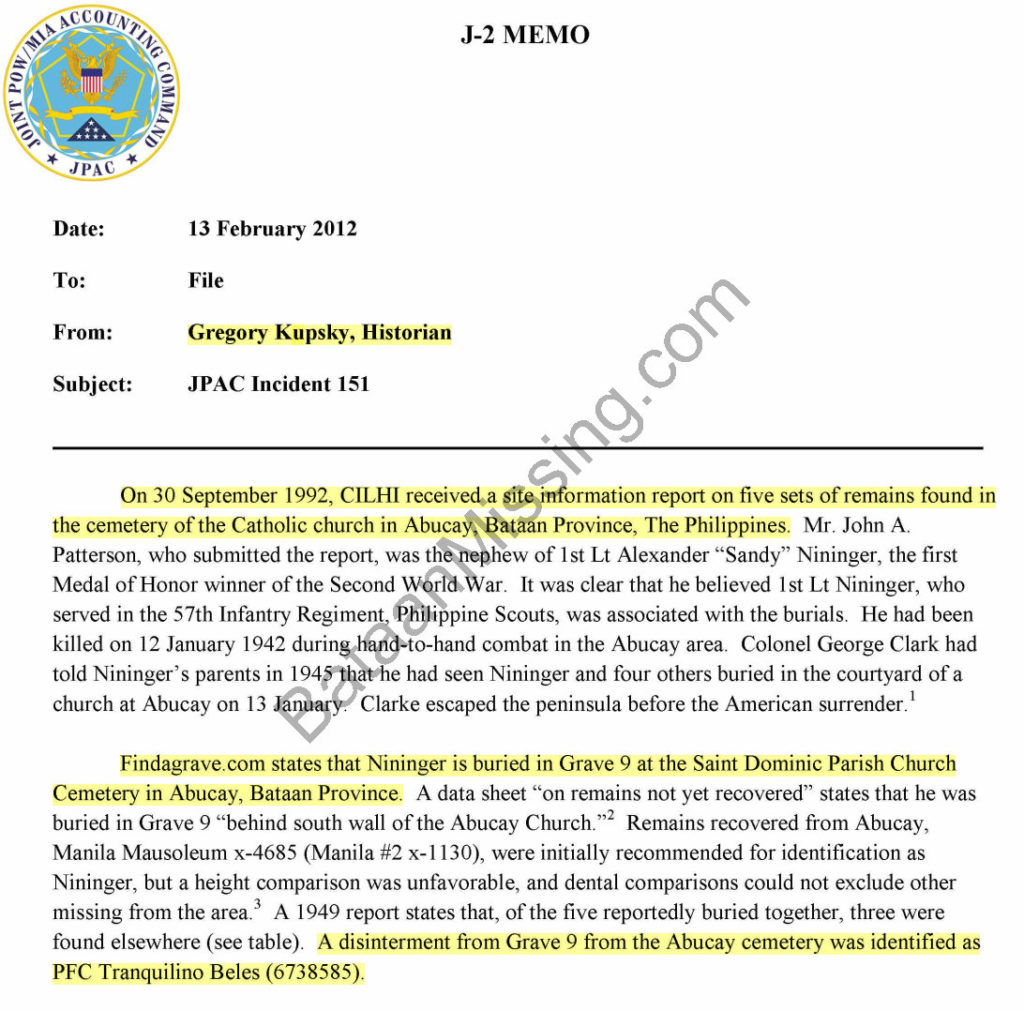

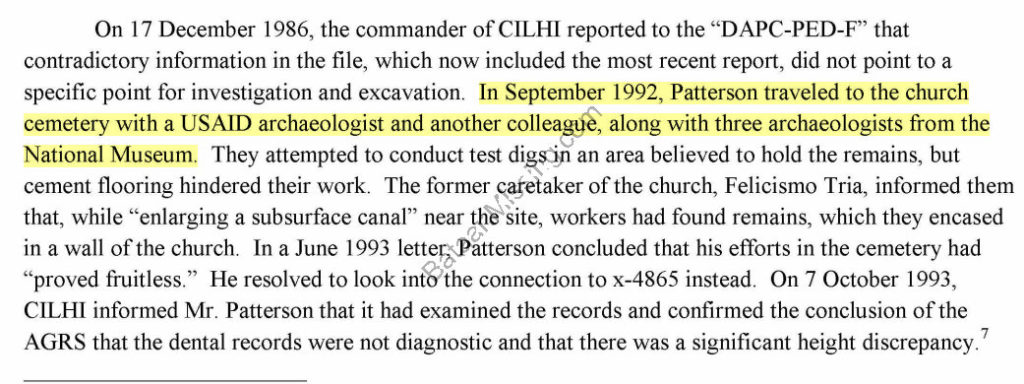
The Churchyard had been thoroughly excavated by multiple search teams without finding the remains Clarke reported had been buried there, yet, the Army’s professional bone finders didn’t think it necessary to look elsewhere.
No one thought it might be a good idea to interview Major Francis, either. Not many creative thinkers at DPAA.
Mr. Kupsky seems to have forgotten all about Major Francis’ information when he testified in court a few years later.
Doing the Same Thing and Expecting a Different Result
On May 25 of 2017, the families of seven MIA’s filed a lawsuit in Federal Court demanding the return of the remains of their missing family members whom they believed were buried as Unknowns in the Manila American Cemetery. The lead plaintiff in this litigation was John Patterson, Nephew of 1LT Alexander R. Nininger. He had been researching the case since before most of the government experts were born.
The lead expert for the government was Gregory Kupsky, the historian who had prepared the 2012 summary noting that the only eyewitness had placed the burials at a location south of the river where the Abucay Cemetery was located and from where the X-1130/X-4685 remains had been recovered.
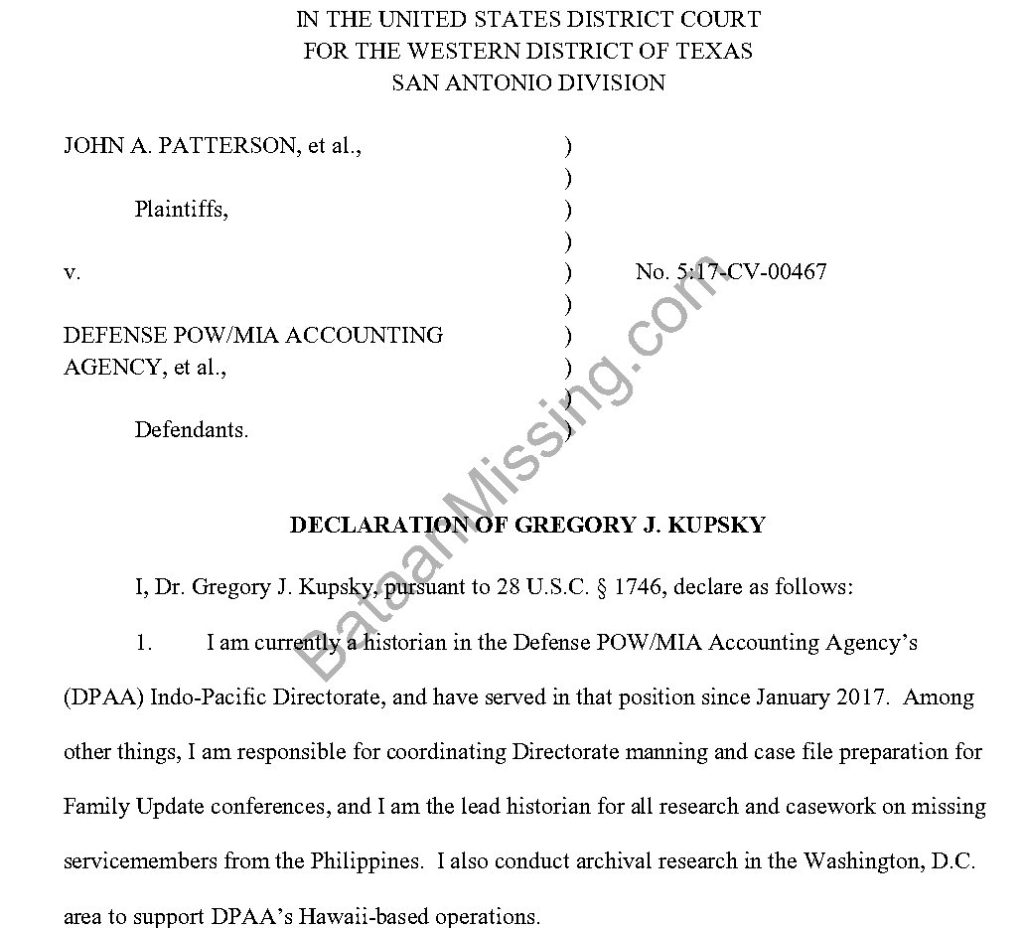
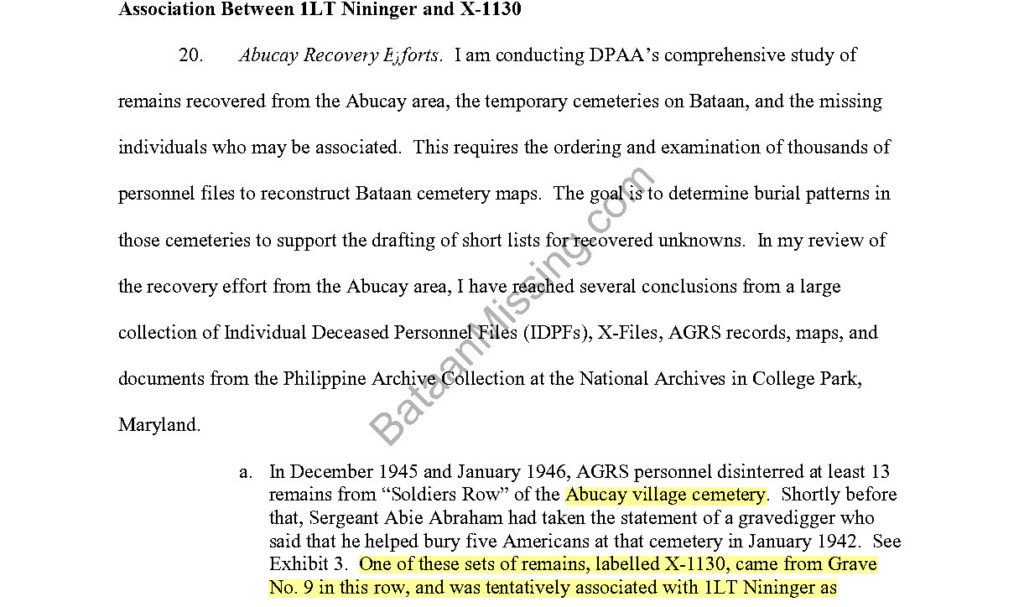
Mr. Kupsky stated that X-1130 came from Grave No. 9 in the Abucay Cemetery
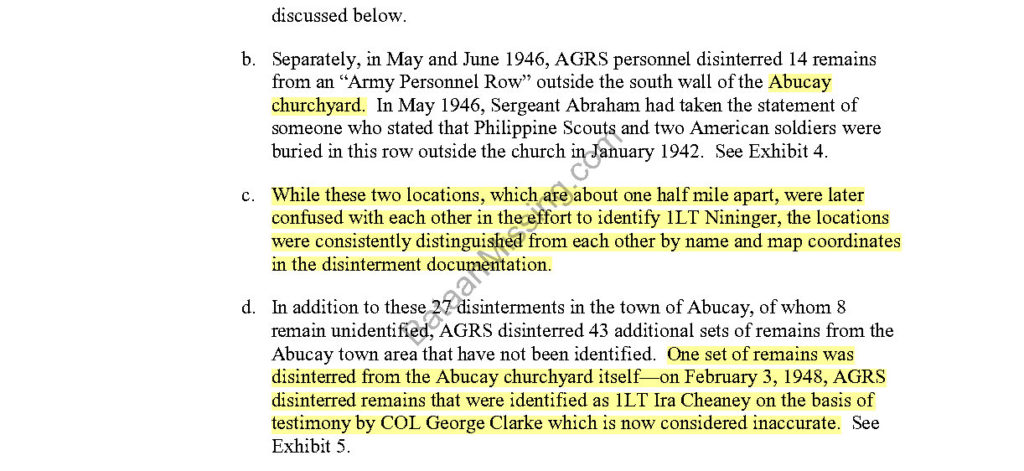
Mr. Kupsky stated that the Abucay Churchyard and Abucay Cemetery were often confused with each other. He further stated that remains identified as 1LT Cheaney were disinterred from the Churchyard on the basis of Clarke’s information.


Mr. Kupsky’s opinion was that COL Clarke’s information was the primary basis for the AGRS to associate the X-1130 remains with 1LT Nininger in that COL Clarke placed the burial in Grave #9 of the Abucay Churchyard and X-1130 was recovered from Grave #9 in the nearby Abucay Cemetery.

Mr. Kupsky is unclear as to when X-1130 was first associated with 1LT Nininger. He thinks the Report of Internment form was used as a worksheet and information was added as it became available.

Mr. Kupsky “suggests” that the “attached letter” referenced on the X-1130 Report of Interment was COL Clarke’s information as provided in a letter from the Nininger and other families.

Mr. Kupsky assumes without evidence that the “attached letter” was based on COL Clarke’s information and there was no other information identifying X-1130. He completely neglects to mention that COL Clarke’s information had been totally discredited both because Clarke had not been present at the burials and that multiple excavations of the churchyard had proven it to be incorrect.

There is no evidence to suggest that AGRS relied primarily on COL Clarke’s letter as suggested by Mr. Kupsky. The AGRS recommendation explained that they actually discounted COL Clarke’s information because it had been found to contain errors as to other burial locations.
Mr. Kupsky’s 2017 declaration did not mention the eyewitness, Major Francis, or that he placed the burial location south of the river opposite the church. Neither did he mention that the Abucay Churchyard had been repeatedly and thoroughly excavated.
The government has always insisted that their objection to exhumation of a grave is their belief in the “sanctity of the grave” and that once interred the remains should not be disturbed.
Many of the Unknowns recovered from Bataan have been repeatedly interred and disinterred. First from their grave on Bataan, then moved to a central cemetery such as Manila #2, then Manila Mausoleum then the Fort McKinley cemetery (now Manila American Cemetery managed by ABMC). Then, at the Manila American Cemetery, Unknowns were often disinterred from the back row of a plot to fill an empty grave at the front of a plot. All for the convenience of the government. So much for the sanctity of the grave objection.
The government wasn’t so concerned about the sanctity of the grave in 2017 when they broke open multiple tombs in the Abucay Churchyard with no more evidence than an internet post by an anonymous person.
A few months after the government was sued by the families, they undertook an ill-conceived project to find the remains of 1LT Nininger in hopes of making the lawsuit moot and getting themselves off the hook. Not being real good at original thinking, they were still convinced that he had been buried in the Abucay Churchyard. Neither the fact that it had been repeatedly excavated nor that the source of the information had been totally discredited, deterred them. They had a solid lead this time. No less an authority than FindAGrave.com told them exactly where to look.
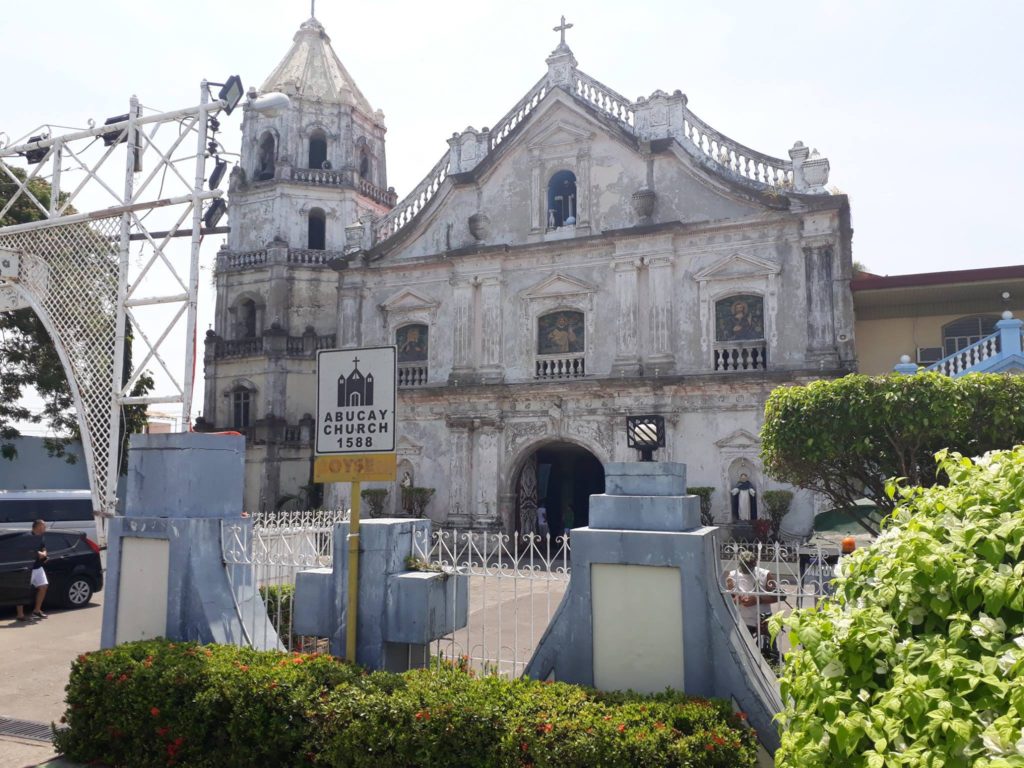
DPAA sprung in to action when they were alerted to a Findagrave.com post by a member using the handle “Anonymous” that 1LT Nininger was buried in a tomb in the Abucay Churchyard. The basis for the post was a plaque on the tomb identifying it as the grave of Alexander Ramsey Nininger, Jr.

Sparing no expense, DPAA broke open five above ground tombs in the Abucay Churchyard. The net result of their efforts was to disturb the graves of some local citizens interred there. Apparently, you just can’t rely on those anonymous plaques anymore.
Here is DPAA’s report of their investigation of the tomb.


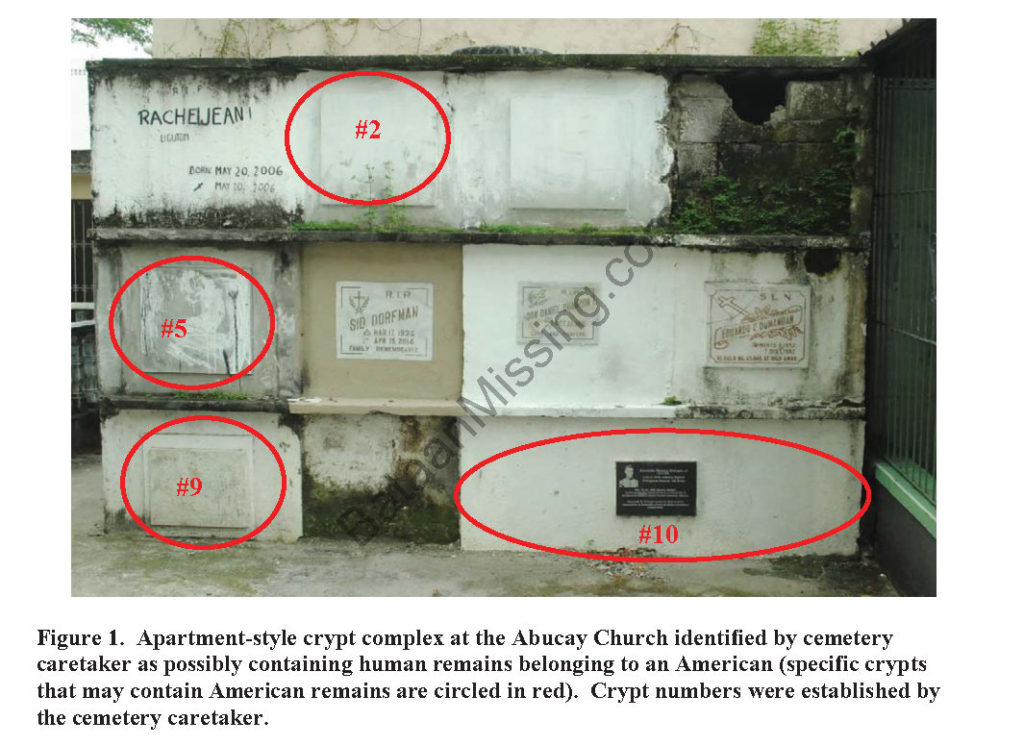
We’re not republishing the photos of the human remains recovered from these tombs as none of them belonged to Nininger. The only thing proved by this boondogle was that the government shouldn’t argue about sanctity of the grave because that is an empty phrase to them.
So what do we know at this point about the burial of 1LT Alexander Nininger –
- The gravedigger said he buried five Americans in the Abucay Cemetery.
- Other officers interviewed state that the deputy commander of the medical detachment, Major Francis, would have been present for Nininger’s burial.
- Major Francis said that Nininger was buried south of the river where the Abucay Cemetery is located.
- The government’s lead expert, Gregory Kupsky is aware of Major Francis’ information, but is careful not to mention him in his 2017 court declarations.
- Major Francis passed away several years ago without ever being interviewed concerning his knowledge of the burials, but his letters survive.
- Remains X-1130/X-4685 were recovered from the Abucay Cemetery.
- The AGRS command repeatedly insisted that X-1130/X-4685 should be identified as 1LT Nininger.
- The Memorial Division in Washington repeatedly disapproved the recommendations because of (COL Clarke’s) discredited information.
- COL Clarke’s information had been repeatedly found to be incorrect.
- The government expert relies on unsubstantiated assumptions to avoid examining X-1130/X-4685. At one point he even states that those remains were recovered from the churchyard rather than the cemetery.
- Colonel George S. Clarke, the disgraced former commander of the 57th Infantry Rgt reported that 1LT Nininger had been buried in Soldiers Row Grave #9 of the Abucay Churchyard.
- Colonel Clarke was not present when Nininger was buried and the source of his information is unknown
- The Abucay Churchyard has no area known as Soldiers Row.
- The Abucay Churchyard had been thoroughly excavated multiple times without result. The remains of only two Americans were recovered from these excavations, Captain H.A. McCurdy and X-3431/X-1671 BTB 1LT John C. Compton both of whom had died at Abucay Hacienda.
- There was a row of graves of soldiers buried outside the church wall. Grave #9 in this row was identified as Philippine Scout PFC Tranquilino Beles, 6738585, by means of an identification tag. (So Nininger could not have been buried in grave #9 at the churchyard because someone else was found to be in it.)
- X-1130/X-4685 was recovered from the Abucay Cemetery Soldiers Row Grave #9.
- The remains of Lt’s Nininger, Compton, Maynard, Green and Wilson have never been identified.
Perhaps just as important is what we don’t know –
- It is unknown why Colonel Clarke would place the location of Nininger’s burial as Abucay Churchyard Soldiers Row #9 since no such location existed, but even Mr. Kupsky admits that the cemetery and churchyard locations were often confused.
- It is unknown what evidence the AGRS relied upon in determining that 1LT Nininger was buried in Grave #9 of the Abucay Cemetery.
- Why did the government’s expert neglect to mention that COL Clarke’s information had been thoroughly discredited or that the only known witness to the burial placed it south of the river.
- Why did the government’s expert assume without evidence that “attached letter” referenced in the X-1130 report of interment contained Clarke’s information and that was the basis for determining that grave 9 contained Nininger’s remains.
There were only two reported locations for the burial of 1LT Nininger, the cemetery and the churchyard. The churchyard had been thoroughly excavated by multiple teams of searchers. There was actually an eyewitness who placed the burial of 1LT Nininger in the cemetery, but the Army had diligently avoided interviewing that witness or examining the X-1130 remains.
Prior to the court’s decision, the government agreed to disinter the graves which the other plaintiff families asserted held the remains of their loved ones. Due to known commingling and conflicting records, there were a total of forty-one graves to be disinterred.
Cabanatuan POW Camp Grave 407 – 9
Cabanatuan POW Camp Grave 704 – 8
Cabanatuan POW Camp Grave 717 – 14
Cabanatuan POW Camp Grave 804 – 4
Colonel Loren Stewart – 3
Brig General Guy Fort – 3
TOTAL GRAVES DISINTERRED – 41
While the government “voluntarily disinterred” – or at least they had not yet been ordered to disinter – forty-one graves to resolve the other six cases. And despite the overwhelming evidence that 1LT Nininger and others were buried in the Abucay Cemetery, the government continues to insist that 1LT Alexander Nininger is buried in a location they have repeatedly investigated without finding anything. Even after the embarrassment of breaking open five more graves with negative results, the government still refuses to further investigate the X-1130/X-4685 remains. One has to ask why?
